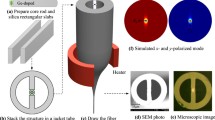The paper deals with the physical principles of development of pressure sensors using changes in the refractive index in the optical fiber microbending. The development of a simplified fiber-optic based pressure sensor is considered to be relevant for the mining industry if used as a temperature-compensated pressure sensor to avoid known disadvantages of various optical interferometers. An important point is the use of a G.652 standard single-mode optical fiber, which is also used as a guide for electrical signal transmission. The proposed information measurement system is capable of making remote measurements of the rock pressure on the powered support. The ground expressions are given to describe a physical process of the pressure measurement based on the photoelastic effect observed at microbending. The obtained results of the field experiments prove changes in the diffraction spot configuration at the optical fiber end depending on microbending. The finite element program Ansys Static Structural is used for a simulation of the mechanical stress on the optical fiber causing its microbending. The proposed sensor can detect not only pressure, but also temperature and rock mass microdisplacement and can be used for geotechnical monitoring of mine openings representing the danger of gas and coal dust explosion.
Similar content being viewed by others
References
X. Liu, C. Wang, T. Liu, et al., Acta Photonica Sinica, 38, 112–114 (2009).
Kumar Atul, Kumar Dheeraj, U. K. Singh, et al., Int. J. Control Autom., 3, 63–70 (2011).
H. Naruse, H. Uehara, T. Deguchi, et al., Meas. Sci. Technol., 18, No. 10, 3202–3210 (2007).
A. V. Yurchenko, A. D. Mekhtiev, Y. G. Neshina, et al., Russ. J. Nondestruct., 54, No. 7, 528–533 (2018).
N. I. Gorlov and V. I. Eirikh, in: Proc. Int. Conf. “Saginovskie Readings 4,” Karaganda (2012), pp. 68–70.
A. V. Yurchenko, N. I. Gorlov, A. D. Mekhtiyev, and А. А. Kovtun, IOP Science: J. Phys. Conf. Ser., 671, 1–6 (2016).
Kh. O. Chotchaev, Geologiya i geofizika yuga Rossii., No. 3, 129–140 (2016).
G. Ya. Buimistryuk, Foton-Ekspress, 43, No. 6, 38–39 (2011).
G. Ya. Buimistryuk, Control Engineering Rossiya, 45, No. 3, 34–40 (2013).
S. T. Kim, Y.-H. Park, S. Y. Park, et al., Sensors (Switzerland), 15, No. 1, 1060–1070 (2015).
T. Liu, Y. Wei, G. Song, et al., in: Proc. Int. Conf. “Microwave and Photonics,” Dhanbad (2013), pp. 102–111.
Yiming Zhao, Nong Zhang1, and Guang-yao Si, Sensors (Switzerland), 16, No. 10, 112–117 (2016).
A. V. Yurchenko, A. D. Mekhtiyev, F. N. Bulatbaev, et al., IOP Conf.: MSE, 516, No. 1, (2019).
V. A. Kalytka, Y. G. Neshina, P. Sh. Madi, and Y. P. Naboko, IOP Conf.: MSE, 698, 1–6 (2019).
S. E. Savotchenko, Russ. Phys. J., 62, No. 1, 3–12 (2019).
Yu. G. Dmitriev and G. M. Koshkin, Russ. Phys. J., 62, No. 4, 649–657 (2019).
Author information
Authors and Affiliations
Corresponding author
Additional information
Translated from Izvestiya Vysshikh Uchebnykh Zavedenii, Fizika, No. 2, pp. 129–136, February, 2020.
Rights and permissions
About this article
Cite this article
Mekhtiev, A.D., Yurchenko, A.V., Neshina, E.G. et al. Physical Principles of Developing Pressure Sensors Using Refractive Index Changes in Optical Fiber Microbending. Russ Phys J 63, 323–331 (2020). https://doi.org/10.1007/s11182-020-02038-y
Received:
Published:
Issue Date:
DOI: https://doi.org/10.1007/s11182-020-02038-y




